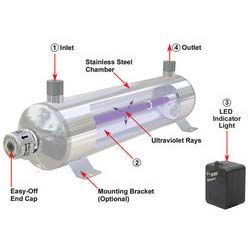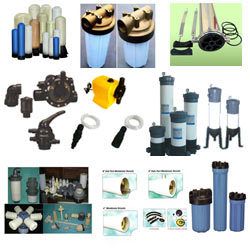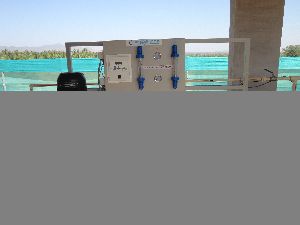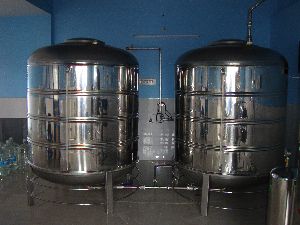
Using ultraviolet SYSTEMS
UV SYSTEMS Using ultraviolet (UV) light for drinking water disinfection dates back to 1910. It is a reliable means of disinfection which involves exposing contaminated water to radiation from UV light. The treatment works because UV light penetrates an organism’s cell walls and disrupts the cell’s genetic material, making reproduction impossible. A special lamp generates the radiation that creates UV light by striking an electric arc through low-pressure mercury vapor. This lamp emits a broad spectrum of radiation with intense peaks at UV wavelengths of 253.7 nanometers (nm) which research has shown is the optimum UV wavelength range to destroy bacteria. For more information on how UV works click here. UV disinfection can remove the threat to health from water borne Pathogens without the creation of disinfection by products that can be generated from drinking water chlorination. From the common bacteria, E-Coli through the Cryptosporidium Oocysts to Adenovirus, UV disinfection is capable of providing effective treatment to ensure inactivation of these pathogens and ensure drinking water is safe. Research has confirmed that UV effectiveness is relatively insensitive to temperature and pH differences.
...more
STP WITH UF
We are specialized in Sewage Treatment Plants and have successfully supplied projects of various sizes in Karnataka and Tamil Nadu.The above projects have been covered in various industries like Textile, Tanneries, Beverages, Sugar Mills, Refineries, Auto mobiles, Pharmaceuticals, Hotels and Resorts etc.,Our position of strength has been attained by our focus on technological advancement through continuous Research and Development.The company has a fill-fledged R&D center where our engineer’s work on new product design, development, Penta Pure Technologies is the company, which provides a complete solution for Effluent Treatment, recycling and zero discharge
...more
STP WITH MULTIGRADE FILTER
Our company provides a wide range of Sewage Treatment plants which can also be manufactured as per the requirement of the client. These plants remove impurities as well as remove the BOD,COD, TSS, and Etc.. Also the plants that we manufacture are in compliance with the set international standards and also find its application in many areas. With the use of cost effective techniques and environmentally friendly approaches in our product design we are able to achieve good client response. Because of the presence of impurities and contamination of water,many industries face difficulty due to these dissolvedparticulatematters.
...more
softener
Hard water is softened by removing the calcium and magnesium it contains. When hard water passes through the softening system’s resin bed, it exchanges the hard ions in the water for soft ones, so only softened water passes through to your home. Once the resin bed fills up with hardness ions, it must be cleaned. Salt is typically used in the regeneration (cleaning) process and restores the resin to a “clean” state so the ion exchange process can begin again.
...more
Sand Filter
Sand filters have proven effective in removing several common pollutants from storm water runoff. Sand filters generally control storm water quality, providing very limited flow rate control. A typical sand filter system consists of two or three chambers or basins. The first is the sedimentation chamber, which removes floatables and heavy sediments. The second is the filtration chamber, which removes additional pollutants by filtering the runoff through a sand bed. The third is the discharge chamber. The treated filtrate normally is then discharged through an underdrain system either to a storm drainage system or directly to surface waters. Sand filters take up little space and can be used on highly developed sites and sites with steep slopes. They can be added to retrofit existing sites. Sand filters are able to achieve high removal efficiencies for sediment, biochemical oxygen demand (BOD), and fecal coliform bacteria. Total metal removal, however, is moderate, and nutrient removal is often low
...more
ro spares
The company presents itself as one of the renowned Manufactures, Suppliers and Exporters of Water Purifier Spare Parts in Bangalore. The wide range of Water Purifier Spare Parts is inclusive of Industries Water and waste water purifier spare parts. We employ the latest technology while manufacturing Water Purifier Spare Parts. These Water Purifier Spare Parts are widely used in different water purifiers. We offer customized packaging facility of Water Purifier Spare Parts. Our customers can avail Water Purifier Spare Parts at market leading price range.
...more
Ro Plant
Reverse osmosis (RO) is a water purification technology that uses a semipermeable membrane. This membrane technology is not properly a filtration method. In reverse osmosis, an applied pressure is used to overcome osmotic pressure, a colligative property, that is driven by chemical potential, a thermodynamic parameter. Reverse osmosis can remove many types of molecules and ions from solutions, and is used in both industrial processes and producing potable water. The result is the solute is retained on the pressurized side of the membrane and the pure solvent is allowed to pass to the other side. To be "selective", this membrane should not allow large molecules or ions through the pores (holes), but should allow smaller components of the solution (such as the solvent) to pass freely. In the normal osmosis process, the solvent naturally moves from an area of low solute concentration (high water potential), through a membrane, to an area of high solute concentration (low water potential). The movement of a pure solvent is driven to reduce the free energy of the system by equalizing solute concentrations on each side of a membrane, generating osmotic pressure. Applying an external pressure to reverse the natural flow of pure solvent, thus, is reverse osmosis. The process is similar to other membrane technology applications. However, key differences are found between reverse osmosis and filtration. The predominant removal mechanism in membrane filtration is straining, or size exclusion, so the process can theoretically achieve perfect exclusion of particles regardless of operational parameters such as influent pressure and concentration. Moreover, reverse osmosis involves a diffusive mechanism, so that separation efficiency is dependent on solute concentration, pressure, and water flux rate.Reverse osmosis is most commonly known for its use in drinking water purification from seawater, removing the salt and other effluent materials from the water molecules.
...more
MS Fabrication
Mild Steel We are manufacturing and exporting a wide assortment of storage tanks vessels acid storage tank RO frames wet panels and pipe lines that can serve the variegated requirements of several industries Our storage tanks vessels acid storage tank RO frameswet panels and pipe lines are fabricated from qualitative material depending upon the requirements of storage during application. Widely acclaimed for their non reactivity and high tensile strength, these tanks, vessels, frames, wet panels and pipe lines are customized for our clients in accordance to their exacting requirements Our range includes vertical storage tanks mild steel storage tanks stainless steel storage tanks horizontal storage tanks and mild steel gasification tanks frames wet panels vessels and pipe lines for Industries water and waste water treatment plant application and etc Rubber Lining Since our inception we have earned a reputation for providing solutions to customers problem in the field of Rubber Lining We extract our Rubber Lining from Natural & Various Synthetic Rubbers to cater to diverse industries with the main motive of serving the Indian and foreign industry with Quality products to increase the efficiency at the work place at cost effective price with our vast experience and knowledge in the field of Rubber Lining This Rubber Lining is very useful for industrial usage Features 1 Superior quality protects against corrosion and metal impurities Rubber Lining 2 Corrosion and abrasion resistant Rubber Lining 3 Ability to withstand tough chemical environments Rubber Lining 4 Heat resistant Rubber Lining
...more
Mixed Bed Plant
Mixed Bed Deionization Mixed bed deionizers are quite superior to two column deionizers in terms of the water quality they produce. As water passes through the mixed bed deionizer it has millions of chances to contact a cation bead, then an anion, then another cation and so on. An exchange takes place of course only when a positive ion contacts a negative ion and vice versa. With each exchange the purity of the water improves because more ions are removed and held by resin beads. This repeated mixed bed deionization process will deliver water that approaches chemically ' pure' water. Standard Mixed Bed Deionizer Features •100 psi Carbon Steel Rubber Lined Tank •Three Sight Glass Windows •Strong Acid Cation and Strong Base Anion Resin •Skid Mounted Schedule 80 PVC piping •PVC Hub Radial Inlet •PVC Header Lateral Middle Collector •Strainer on Plate Bottom Collector •Thermal Safety Valve •CI Butterfly Valve with SS disc & EPDM Seat or Ball Valves •Inlet/Outlet Pressure gauges •Conductivity Analyzer on Product •Signet Flow meter on Feed •NEMW 4 CS Local Control Box •PLC controls Mixed Bed Deionization Applications •As a Working Mixed Bed Deionizer •As a Polishing Mixed Bed •Condensate polishing •When Maximum Silica Removal is required •When Chemically Pure Water is required
...more
Lamella Clarifier
A lamella clarifier (also lamella separator, lamella thickener) is used to separate sedimentable solid (sedimentation particles) from liquids. In general, particles larger than approx. 50µm (and of higher density than the liquid) can be separated by sedimentation. Particles of smaller size can be separated using coagulation aids. Our lamella clarifier can be manufactured from laboratory size to industrial dimensions. The casing is typically made of coated or stainless steel and the lamellas are made of propylene.
...more
Iron Removal Filter
Iron removal plants can be based on different filtration media, depending on the iron and manganese concentration, the oxygen level, CO2 content and hardness of the water.Plant principle:First, air is injected in order to oxidize the iron. The oxidized iron will then precipitate on a sand filter. An MnO2 layer in the sand bed will catalyze the oxidation of residual iron. Backwash will be done by water and by air. Filtration Media choice are:- Sand + MnO2 for high iron concentrations- Calcite for acidic waters - Birm- Greensand Other oxidation chemicals can be used for highly contaminated waters-Ozone - Chlorine- Chlorine DioxideThese chemicals also have a biocide effect but might interact with other component.
...more
DM Plant
Deionized water also known as demineralized water is water that has had its mineral ions removed. Mineral ions such as cations of sodium, calcium, iron, copper, etc and anions such as chloride, sulphate, nitrate, etc are common ions present in water. Deionization is a physical process which uses specially-manufactured ion exchange resins which provides ion exchange site for the replacement of the mineral salts in water with water forming H+ and OH- ions. Because the majority of water impurities are dissolved salts, deionization produces a high purity water that is generally similar to distilled water, and this process is quick and without scale buildup.
...more
Chemical Dosing Systems
The Chemical Dosing Systems we manufacture are designed for perfection. Our range has gained the faith of our customer for their host of qualitative feature such as long service life, high performance and sturdy construction. Available in different specifications the entire range can also be customized as specified by the clients. Chemical Dosing Pump/System We fabricate optimum quality chemical dosing pumps and systems that offers correct quantity of dosing chemical in the stream. These chemical dosing pumps/systems are used in different chemicals such as acids, alkali, chlorine, anti-scalent, alum, SBS, polyelectrolyte and others. Moreover, we also have the ability to customize our range as specified by the clients.
...more
commercial water cooling tower

bottle shape frp cooling towers

vertical cooling tower

commercial cooling tower

Industrial Cooling Tower

nano filtration plants

ozone water purifiers

SS Fabrication
Types of Stainless Steel The three main types of stainless steels are austenitic, ferritic, and martensitic. These three types of steels are identified by their microstructure or predominant crystal phase. Austenitic:Austenitic steels have austenite as their primary phase (face centered cubic crystal). These are alloys containing chromium and nickel (sometimes manganese and nitrogen), structured around the Type 302 composition of iron, 18% chromium, and 8% nickel. Austenitic steels are not hard enable by heat treatment. The most familiar stainless steel is probably Type 304, sometimes called T304 or simply 304. Type 304 surgical stainless steel is austenitic steel containing 18-20% chromium and 8-10% nickel. Ferritic:Ferritic steels have ferrite (body centered cubic crystal) as their main phase. These steels contain iron and chromium, based on the Type 430 composition of 17% chromium. Ferritic steel is less ductile than austenitic steel and is not hard enable by heat treatment. Martensitic:The characteristic orthorhombic marten site microstructure was first observed by German microscopist Adolf Martens around 1890. Martensitic steels are low carbon steels built around the Type 410 composition of iron, 12% chromium, and 0.12% carbon. They may be tempered and hardened. Marten site gives steel great hardness, but it also reduces its toughness and makes it brittle, so few steels are fully hardened. There are also other grades of stainless steels, such as precipitation-hardened, duplex, and cast stainless steels. Stainless steel can be produced in a variety of finishes and textures and can be tinted over a broad spectrum of colors.
...moreBe first to Rate
Rate This